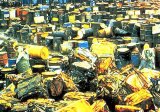EPA Research in Kentucky
EPA researchers are working hard to protect communities across the nation. Learn about some of the work EPA researchers are doing in Kentucky.
- Helping Community Drinking Water Systems Find Cost-Effective Solutions to Treatment Challenges
- Real-Time Water Distribution System Analysis
- Assessing Impacts of Green Infrastructure on Groundwater Quality
- Understanding Air Pollutants in Rubbertown Industrial Area of Louisville, Kentucky
- EPA Researchers Analyze How Warming Temperatures Will Affect Harmful Algal Blooms in Reservoirs
- Greener Cleanup Tool Reduces Environmental Footprint and Provides Comparable Measures
- Sourcing Urban Soil Contaminants to Improve Cleanup
- Water-On-Wheels Mobile Emergency Water Treatment System
For more EPA work, see EPA in Kentucky.
Helping Community Drinking Water Systems Find Cost-Effective Solutions to Treatment Challenges
Emerging contaminants, such as per- and polyfluoroalkyl substances (PFAS), are challenging to drinking water systems across the country. Effective treatment for emerging contaminants can be unknown, difficult, and extremely costly. Working with the state of Kentucky, EPA researchers are providing technical assistance to three medium-sized and four large community water systems with PFAS concerns to help them identify optimal, cost-effective treatment methods and optimize the long-term operation of their chosen technology. These efforts will also be used to develop best practices and performance and cost estimate tools so water utilities across the country can make informed treatment and operational choices.
Real-Time Water Distribution System Analysis
EPA's tool EPANET-RTX gives water utilities the necessary tools to enhance system operations including emergency response and improved operations, e.g., better pressure management, leak detection and water quality. EPANET-RTX has been tested or demonstrated in several locations including Ohio, Colorado, Florida, Kentucky, and Michigan.
Assessing Impacts of Green Infrastructure on Groundwater Quality
Green infrastructure reduces stress on wastewater systems, decreases sewer overflows, and improves watershed health — but how does it impact groundwater quality? EPA recently completed comprehensive multi-year studies in Kansas, Washington and Kentucky to find out. The data collected can be used by state and local agencies to make decisions about implementing green infrastructure in their communities. Read Assessing Impacts of Green Infrastructure on Groundwater Quality.
Understanding Air Pollutants in Rubbertown Industrial Area of Louisville, Kentucky
The Rubbertown industrial area of Louisville, Kentucky, is home to over 10 industrial sources of air pollutants. To help understand how the emissions from these sources impact people living nearby, EPA collaborated with the City of Louisville Metro Air Pollution Control District to measure hazardous air pollutants in the area. Read Next Generation Emission Measurements Help Understand Air Pollutants in Rubbertown Industrial Area of Louisville, Kentucky.
EPA Researchers Analyze How Warming Temperatures Will Affect Harmful Algal Blooms in Reservoirs
Climate change and ongoing nutrient pollution may cause more frequent and intense cyanobacterial blooms. However, there is limited historical monitoring data that can show the rate and severity of the potential increase. To address this issue, EPA scientists collaborated with U.S. Army Corps of Engineers to compile and analyze over 30 years of monitoring data from 20 U.S. reservoirs located in Indiana, Kentucky, and Ohio. Read EPA Researchers Analyze 30 Years of Data to Understand How Warming Temperatures Will Affect Harmful Algal Blooms in Reservoirs.
Greener Cleanup Tool Reduces Environmental Footprint and Provides Comparable Measures

Contaminated sites such as the Valley of the Drums in Kentucky is vital to improve environmental and public health conditions, but cleanup activities also use energy, water, and other resources. EPA scientists developed 14 greener cleanup metrics that may be used to quantify specific portions of the environmental footprint of cleanup activities. Read Greener Cleanup Tool Reduces Environmental Footprint and Provides Comparable Measures.
Sourcing Urban Soil Contaminants to Improve Cleanup
Identifying the source of soil contaminants is vital to decision-making during an environmental cleanup. That's why EPA scientists partnered with several southeastern states to figure out how urban background contaminants differ from industrial waste at urban sites, including sites in Louisville and Lexington. Read Sourcing Urban Soil Contaminants to Improve Cleanup.
Water-On-Wheels Mobile Emergency Water Treatment System
EPA's Office of Research and Development, in partnership with WaterStep, developed and patented the affordable and versatile Water-On-Wheels Mobile Emergency Water Treatment System (WOW Cart). In August 2022, deadly flooding occurred in Eastern Kentucky and the public water supply was lost for weeks. Working with state agencies, WaterStep and the Kentucky Rural Water Association were able to set up four WOW carts in the communities of Hazard, Buckhorn and Mayking. The WOW Carts supplied potable water and disinfectant for food facilities, mobile showers, laundry trucks, and displaced people.
